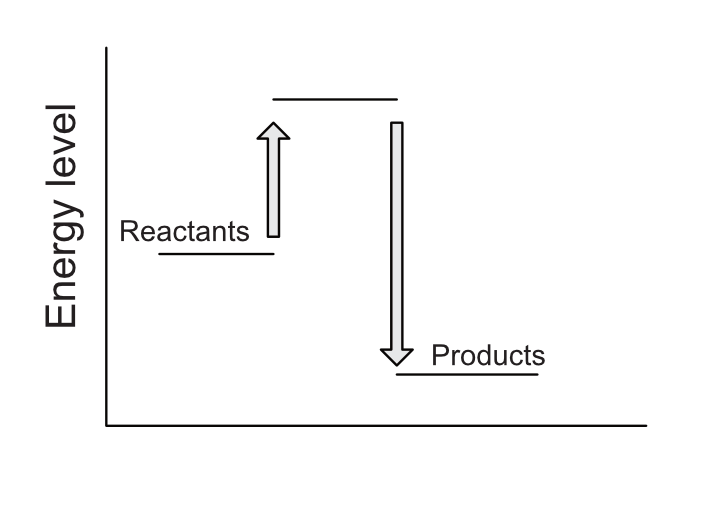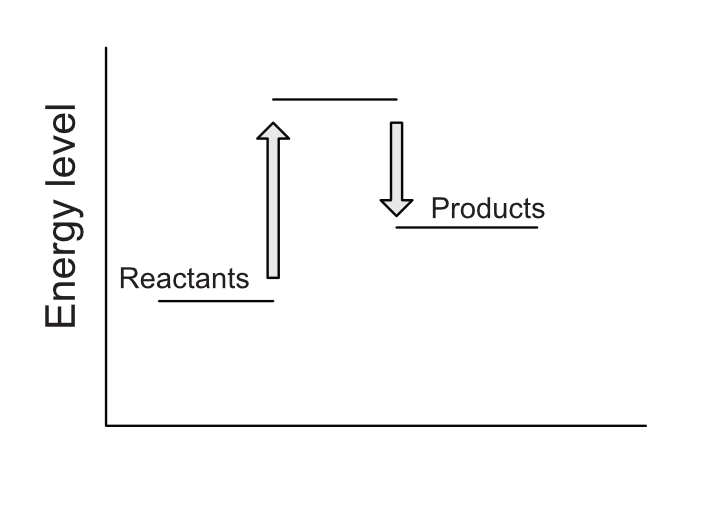Energetics
Exothermic Reactions
An exothermic reaction is one in which__ energy is released to the environment__. This is often in the form of thermal, light and sometimes sound energy.
The energy level of the bonds in the products is lower than the energy level of the bonds in the reactants. Energy has to be supplied to start the reactions as the bonds in the reactants have to be broken before the reaction can start. An example of this would be striking a match, the heat from the friction is need to start the reaction, once it begins the energy released by the reaction can break the remaining bonds and so the reaction continues with no further input from the surroundings.
The diagram show difference in the energy levels of the reactants compared to the products. The difference is the amount of energy released to the environment.
Exothermic reactions results in an increase in the temperature of the surrounds and/or the emission of light or sound.
Examples:
- Combustion: releases thermal, light and sometime sound energy too (as in an explosion).
- Thermite reaction
- Rusting of iron to form iron oxide, (slow process)
- Neutralization reactions (acid + base → salt + water and heat energy)
- Respiration, (energy released from sugars in the form of high energy bonds of ATP)
- Dissolving of copper sulfate into water
- Nuclear fission, (see physics section of this course)
Activation Energy
All reactions whether they are endothermic or exothermic have to take in some energy from the surroundings to break the bonds of the reactants for the reaction to start. This initial energy is known as the activation energy. If the energy supplied is less than this activation energy the reaction will not start.
In an exothermic reaction this activation energy only has to supplied from the surroundings at the being of the reaction. After that the energy released by the reaction is more than required to supplied the activation energy for the rest of the reactants. The reaction is self-sustaining, for example a candle needs to be lite from a match to provide the activation energy for the wax to burn. Once burning the heat from the flame is more than enough to sustain the burning of the rest of the wax.
In an endothermic reaction, no surplus energy is released from the reaction, therefore, for the reaction to continue energy must be continually supplied from the surroundings. If this is not supplied the reaction will stop. Photosynthesis, for example, will only occur as long as there is a light source of a high enough intensity to drive the reaction.
Endothermic Reactions
Endotheric reactions are chemical reactions that __take in energy __from their surrounds.
When a reaction takes place the existing bonds between the elements that make up the reactants have to be broken, some energy is also required to overcome the intermolecular forces that hold structures together. This requires energy to be supplied from the surroundings normally in the form of thermal (heat) energy. As the new products are formed the new bonds have a certain energy level. If the new energy level of the bonds in the products is greater than the original energy stored in the bonds of the reactants the reaction is endothermic.
The energy level of the reactants and the products can be represented in a single graph. The energy levels increase initially, in this example the products contain more energy than the reactants so energy has had to be supplied from the environment.
Endothermic reaction result in a drop in temperature of the surroundings.
Physical changes as well as chemical changes can be endothermic.
Examples:
- Dissolving of ammonium chloride into water
- Cracking of alkanes hydrocarbons
- Baking soda and vinegar
- Photosynthesis (the energy taking in from the surroundings is light rather than thermal)
- Melting ice
Bond Energy Changes
Each type of bond between different atoms requires a specific amount of energy to break, this same energy is released when the bond forms.
When two hydrogen atoms bond to form a molecules of hydrogen, H2 it released 432 KJ per mol. To break this bond 432 KJ / mol must be supplied.
By comparing the energy required to break the bonds of the reactants with the energy released when the bonds form to make the products the amount of energy released or required for the reaction can be calculated.
Example 1
C + O2 → CO2
Energy to break an O2(0=0) bond: 494 KJ /mol
Energy released forming a C-O bond: 358 KJ/mol
CO2 has two C-O bonds (O-C-O)
Energy supplied to the reactants: 494 KJ/mol to break the O=O bond.
Energy released forming the two bonds for the CO2 : 2 x 358 = 770 KJ/mol.
Energy difference = Energy supplied to reactants - energy released from products
= 494 - 770
= -276 KJ / mol
This means that the products have 276 KJ/mol less energy than the products. This is the amount of energy released to the environment. As energy is released this is an exothermic reaction.
Example 2
Reduction of copper oxide by heating.
2CuO → 2Cu + O2
Energy supplied to break Cu-O bond: 686 KJ/mol
Energy released forming a O=O bond : 494 KJ/mol
Energy supplied to reactants: 2 x 343 = 686 KJ / mol
Energy released from products: 1 x 494 = 494 KJ /mol
Energy difference = 686 - 494 = +192 KJ/mol.
The reaction needs to take in 192 KJ/ mol from the surroundings, it is an endothermic reaction.

